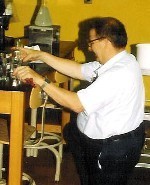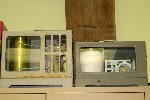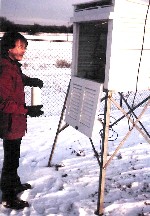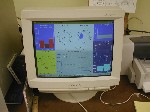We Have Weather
Posted on Monday, March 19, 2007
As I write, on a Monday near the end of winter, we have snow on the ground and new flakes are falling. We sometimes attach value-words to weather - good weather, bad weather - as if our feelings or preferences should affect nature! Weather is to climate as one day on the job is to a career. Weather data, when accumulated, give us a picture of climate. We generally describe climate in terms of averages or means of temperature fluctuations, precipitation (including snow) and wind. We describe weather by the immediate, or daily, conditions that prevail.
Although the average climate of Pennsylvania is usually described as 70o F in summer and 30o F in winter, a true average climate for the state does not exist. This is because Pennsylvania actually has five temperature zones and subzones. At the Field Station we measure weather and, eventually, should be able to put together a general picture of climate for our immediate area.
Here is a small piece of history of the weather instrumentation at the Field Station. Dr. Bob Travis started collecting weather data in 1977 in his backyard at 620 South Market Street before the property on the Fayette-New Wilmington Road was designated as an environmental study area. In July 1982, he established the site of the weather station on a hill at the Field Station. He had the foresight to enclose the weather station with a chain-link fence, put up a pipe as a tower for a wind-speed indicator and bury two cables (one for power and another for data to connect with the old barn, now the Nature Center, 300 feet away). All equipment in the original weather box ran ink charts with a wind-up spring so, initially, there was no need for power or data lines. The rain gauge needs no power. The buried lines came into use 24 years later when, at the turn of the century in January 2001, the weather station became "hi-tech." We now need data and power lines.
For his dedication as the first Director of the field station and his work in installing a weather station at the facility, the Board of Trustees of Westminster named the Robert V. Travis Weather Station in 2003. By then, Bob was Professor emeritus and had retired to his passions of beekeeping and volunteer work at the agriculture extension service in New Castle. He, nevertheless, pays attention to weather. Bob and his wife Audrie still live on South Market where the initial weather station had been marking temperatures and precipitation in their backyard!
I've kept Bob's data books current on weather for our section of Lawrence County, one mile east of New Wilmington. Each month I report data to the County Conservation District as one of 13 stations. Except for a brief hiatus when the instruments were down, we have continuous records dating back to 1977. The usual and continuing weather station parameters were originally four: weekly precipitation and daily chart records of air temperature barometric pressure and humidity.
The computerized weather station was geared up for January 1, 2001 and we now record 17 weather points at 10-minute intervals. These data are transferred from a data logger in the weather box by buried data cable to a computer in the Nature Center every noon and midnight. We can retrieve data and time for barometric pressure, humidity, precipitation, wind speed, wind chill and evapotranspiration in addition to other weather markers. We record soil temperatures on a weekly basis to a depth of 24 inches (60 cm). On a computer screen we can retrieve a continual picture of current weather. We can even tell by looking on the computer screen when the sun rises and sets!
Each Monday, since weather records were kept (and with a few exceptions), the data for the past week are converted from wind-up recorder charts or computer files to a hard copy. Computers are known to crash and having the hard copy preserves the details we have accumulated since weather records were started by Bob Travis. What do we do with all this information? We study it, tweak it, summarize it . . . and we think about it. And, another question I'm often asked, are we experiencing global warming here in New Wilmington?
That is a "climate question" not answered by our 30 years of data alone. Most weather scientists (called meteorologists) are convinced that climate change is occurring. "No doubt about it," they say. The data from measurements, even going back to ancient ice in the polar regions, support the conclusion. The bigger question is the role of humans as the cause of climate change.
What I can prove, based on a limited time frame of 25 to 30 years is that we do have fluctuations in air temperature and precipitation. The "annual mean temperature" (or, AMT, that's the average of all daily temperatures for the year) in 1981 (based on Dr. Travis' chart records) was 49.48o Fahrenheit (9.71 Co as we record it). Twenty years later, in 2001 hi-tech records, the AMT was 50.69o F (10.383o C). Hmmm. So we have global warming in New Wilmington, right? Not necessarily! Science teaches us to NOT jump to conclusions. For example, the AMT for 2006 was 49.34o F (9.63o C), a cooling! Weather data, to help answer the big climate questions, need to be accumulated for 80 to 100 years. Then we might begin to answer the big questions. And that "Monday to Monday" weather check is what we are doing . . . and expect to continue doing at the Field Station. We are carefully recording information for the future. We also reference our records with "Pennsylvania Climatologist," an on-line accumulation of weather data collected in New Castle since 1926 and in Mercer since 1950.
Clarence Harms, Director
Field Station




More Stories



